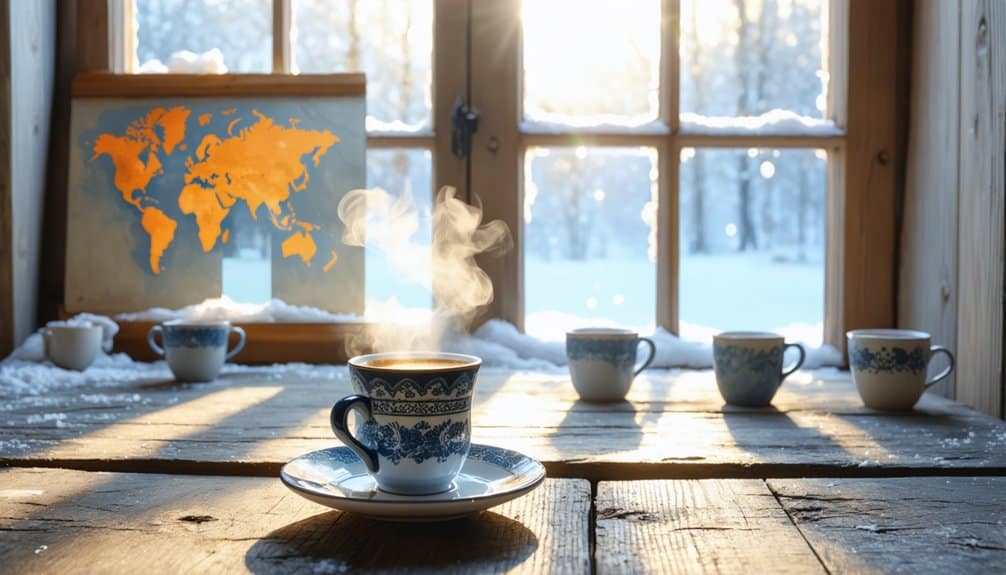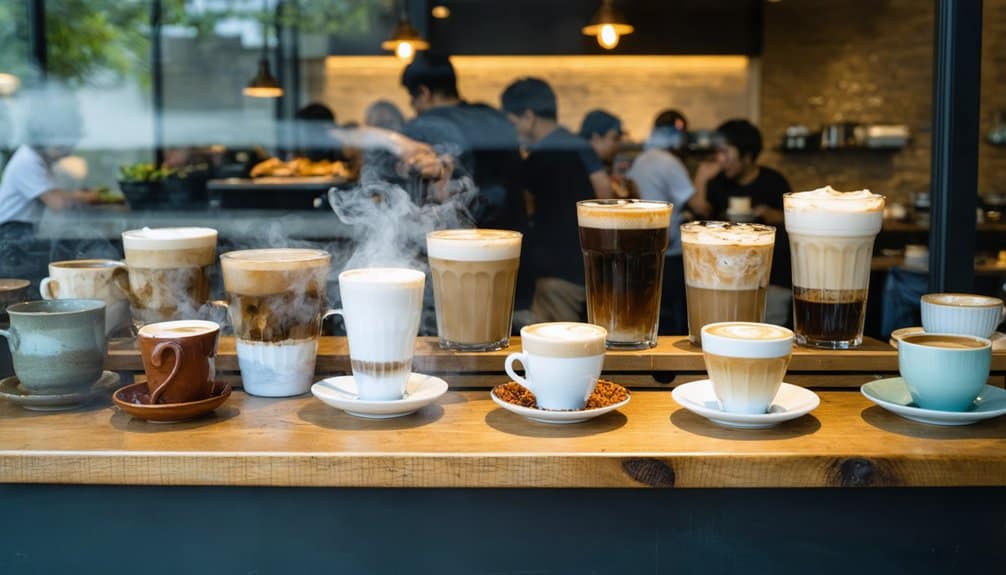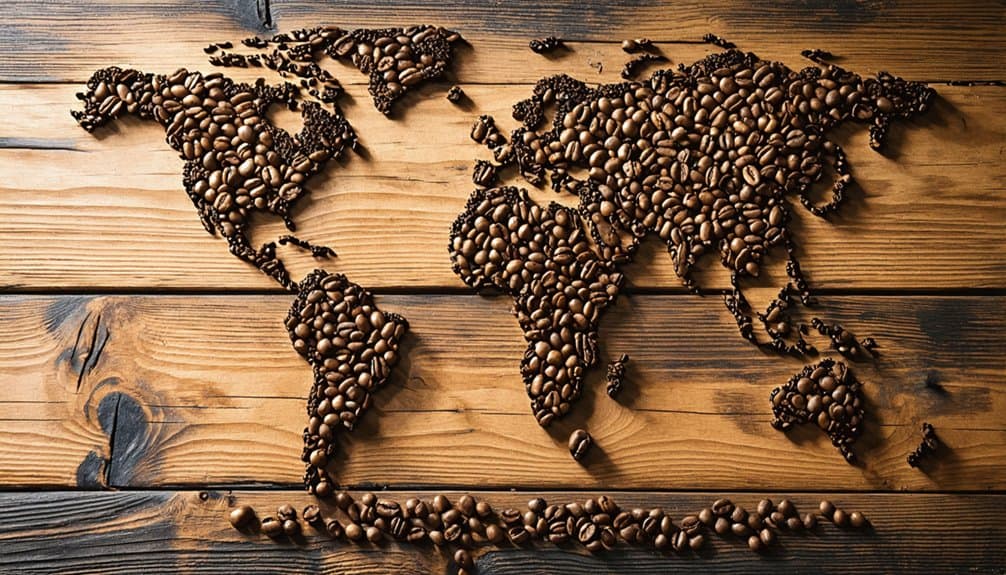Nordic nations dominate global coffee consumption, with Finland leading at a staggering 12 kg per capita annually.
You’ll find Sweden following at 9.9 kg and Norway at 8.6 kg, while Iceland consumes 9 kg per person yearly.
Though the U.S. and Brazil represent the largest coffee markets by volume, they don’t match Nordic per-capita rates.
The coffee landscape’s shifting dramatically as Asian markets, particularly Japan’s $34.45 billion market, reshape consumption patterns worldwide.
Key Takeaways
- Nordic countries lead global coffee consumption, with Finland at 12kg per capita, followed by Sweden, Iceland, Norway, and Denmark.
- Americans drink 517 million cups daily, with 66% of adults consuming coffee every day.
- The 60+ age demographic leads consumption at 72%, though younger generations are increasingly drinking coffee.
- Japan and China represent significant Asian markets, with China’s growth expected to rival US consumption levels.
- Women spend more annually on coffee ($2,327) than men ($1,934), though men generally consume more coffee globally.
Nordic Nations Lead the World in Per Capita Coffee Consumption

The Nordic countries dominate global coffee consumption rankings, with Finland leading at 12 kg per capita, followed by Sweden at 9.9 kg and Norway at 8.6 kg.
Iceland and Denmark round out the Nordic coffee powerhouses, consuming 9 kg and 6.6 kg per capita respectively.
You’ll find coffee deeply woven into Nordic social fabric, with coffee shops serving as community hubs.
The trend dates back to the late 17th century, strengthened by historical factors like alcohol prohibition and strict drinking laws.
During COVID-19, while HoReCa segments declined by 14-27%, retail sales surged as Nordic residents shifted to home brewing.
Swedish consumers particularly embrace the specialty coffee segment, with 80-100 micro-roasters actively operating in the country.
Volume Giants: United States and Brazil’s Massive Coffee Markets
Despite their lower per-capita consumption rates compared to Nordic nations, America’s vast population and Brazil’s coffee culture have created two of the world’s largest coffee markets by volume.
You’ll find Americans consuming a staggering 517 million cups daily, with 66% of adults drinking coffee every day.
The pandemic has dramatically shifted consumption patterns, driving an 85% increase in at-home coffee drinking. While the 60+ demographic leads consumption at 72%, younger groups are catching up.
Women are investing more in their coffee habits, spending $2,327 annually compared to men’s $1,934.
Daily consumption has reached a 20-year high, particularly among those 25 and older.
Drip coffee makers remain the preferred brewing method for 41% of at-home coffee drinkers.
The Rise of Coffee Culture in Asian Markets

While traditional tea-drinking nations once dominated Asian beverage markets, robust coffee consumption has surged across the region, with Japan leading at $34.45 billion in sales followed by China’s rapidly expanding $14.25 billion market.
You’ll find Vietnam and Indonesia emerging as powerhouse producers, ranking second and fourth globally.
China’s near double-digit growth positions it to rival U.S. consumption levels, while specialty coffee grows at 15.3% annually until 2030.
Young, urban consumers are driving this transformation, embracing third-wave coffee culture with its emphasis on quality, sustainability, and creative brewing methods. Independent cafes and domestic chains now flourish alongside international brands.
The pandemic has accelerated at-home coffee consumption as remote work culture drives increased investment in personal brewing equipment and premium coffee products.
Demographics and Coffee: Age and Gender Patterns
According to global data, maturity greatly shapes coffee consumption patterns, with older adults drinking more coffee than younger generations.
In the US, 72% of those 60+ years old drink coffee, compared to just 37% of teenagers. Gender differences also emerge, with men consuming slightly more coffee globally, though regional variations exist.
Baby Boomers at 84% represent the highest coffee-consuming generation worldwide.
- You’ll find higher coffee consumption among the 25-39 demographic in Australia
- You’re part of China’s growing coffee culture if you’re a millennial or Gen Z
- You’re likely to drink 1.93 cups daily if you’re a US male, 1.82 if female
- You’ll notice women prefer sweeter coffee while men opt for stronger brews
Regional Coffee Drinking Habits Across Continents

You’ll find the world’s highest coffee consumption rates in Nordic countries, where per capita intake considerably outpaces other regions.
While traditional tea-drinking Asian markets are experiencing rapid coffee culture growth, particularly in urban centers of China and Japan, South Korea stands out for already preferring coffee over tea.
The Americas showcase diverse coffee traditions, from Mexico’s spiced café de olla to Brazil’s café com leite, with North American markets dominated by major coffee chains and emerging artisanal scenes.
Even though coffee holds strong popularity in the Americas and continental Europe, many of the historical centers like Java and Turkey have shifted to primarily drinking tea.
Nordic Coffee Culture Dominates
Despite the relatively small population of Nordic countries, their coffee consumption dominates global rankings, with Finland leading worldwide at the highest per-capita consumption. Sweden, Norway, and Denmark follow closely, all ranking in the top ten globally.
You’ll find these distinct characteristics in Nordic coffee culture:
- Daily consumption averages over 3 cups per person
- “Fika” tradition emphasizes social coffee breaks
- Fresh brewing is standard when hosting visitors
- Zero-tolerance drink-driving laws have shifted social preferences from alcohol to coffee
The market shows steady growth in retail volume, with increasing demand for higher-quality beans, though the HoReCa segment faces intense competition post-pandemic.
Scandinavian consumers strongly prefer ground coffee sales at 77% of total coffee purchases.
Asia’s Rising Coffee Scene
While Nordic countries lead in per-capita consumption, Asia’s coffee market has emerged as the world’s fastest-growing region, with China’s consumption surging 140% from 2018-21.
You’ll find Japan leading the market at $34.45 billion, followed by China at $14.25 billion and South Korea at $12.6 billion. Instant coffee mixes dominate regional sales due to their convenience and affordability.
You’re witnessing a transformation driven by young urban consumers who favor local brands like Vietnam’s Trung Nguyen and China’s Luckin Coffee.
The region’s cafe culture is booming, with Indonesia’s domestic consumption now surpassing traditional coffee markets like Australia.
As Asia’s producers gain recognition in specialty coffee, Vietnam and Indonesia are cementing their positions as global coffee powerhouses.
Americas’ Diverse Drinking Traditions
As coffee consumption reaches a 20-year peak in America, with 67% of adults drinking it daily, distinct regional patterns have emerged across the continent.
You’ll find the Northeast leading in specialty coffee, while the South dominates frozen blended beverages. The West Coast stands out for its gourmet coffee culture.
The coffee industry jobs support 2.2 million Americans across all states and territories.
Your coffee preferences likely align with these regional trends:
- 83% of coffee drinkers now brew at home
- Drip makers remain the top choice at 37%
- Single-serve machines follow at 28%
- Ready-to-drink coffee has surged to 15%
The 25-39 demographic drives specialty coffee growth, with 66% consuming it weekly.
Specialty Coffee’s Impact on Global Consumption Trends
The specialty coffee market has revolutionized global consumption patterns, with its market size reaching USD 101.6 billion in 2024 and projected growth at 10.4% CAGR through 2030.
You’ll find younger consumers leading this transformation, as 66% of 25-39-year-olds drink specialty coffee weekly, consuming an average of 2.8 cups daily.
Consumers increasingly prioritize fair trade sourcing when making coffee purchases.
You’re part of a growing trend that’s reshaping coffee culture, especially in urban areas where away-from-home channels dominate 72.5% of revenue.
The rise of remote work has turned cafes into social hubs, while social media drives demand for artisanal experiences like single-origin brews and expert barista techniques.
FAQs
How Does Climate Affect a Nation’s Coffee Consumption Habits?
You’ll find your coffee cravings drop 12% in summer but rise in colder months. Climate change’s impact on production affects prices and availability, pushing you toward cold brew alternatives.
What Impact Does Coffee Pricing Have on Consumption Across Different Regions?
You’ll notice higher prices impact consumption less in wealthy regions like Canada and Luxembourg, while emerging markets show price sensitivity, despite China’s 15% consumption growth amid 65% price increases.
Which Brewing Methods Are Most Popular in Different Countries?
You’ll find 80% of UK homes use instant coffee, while drip makers dominate the US market. In Europe, you’re likely to encounter espresso machines, and Asia favors diverse traditional steeping methods.
How Does Education Level Correlate With Coffee Consumption Patterns?
You’ll find higher education correlates with increased coffee consumption, with 92% of students drinking caffeine regularly. Female students consume more coffee, while male students prefer energy drinks and sodas.
What Percentage of Coffee Drinkers Prefer Decaf Versus Regular Coffee Worldwide?
In summary, you can’t pin down exact global decaf vs regular coffee preferences. Current market data doesn’t track this metric thoroughly, though most coffee consumed worldwide is regular.
The Bottom Line
Picture coffee consumption as a global river system: Nordic countries flow the strongest per person, while the US and Brazil form vast oceans of total volume.
You’ll find Asia’s tributaries growing wider each year, fed by young urban professionals.
As specialty coffee creates new channels, you’re witnessing a market transformation where traditional demographics blend with emerging consumption patterns, reshaping the $465 billion industry’s landscape.